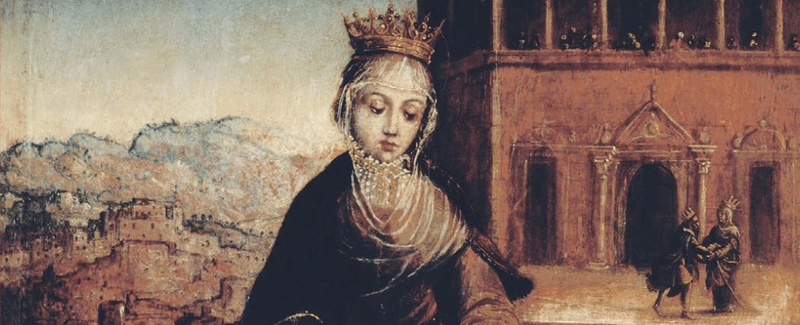Saint Elizabeth of Portugal: The Great Peacemaker

On July 4, Franciscans celebrate the memory of St. Elizabeth (Isabel) of Portugal, Secular Franciscan (1271-1336), known in her lifetime as a great peacemaker. (In the United States, her feast is observed on July 5 since July 4 is Independence Day.)
A great beauty and highly intelligent
The daughter of King Peter III of Aragon, Elizabeth was named after her great-aunt, Saint Elizabeth of Hungary. Considered both a great beauty and highly intelligent, she was married in 1282 to King Denis of Portugal. Denis was a very able ruler but took his wife for granted and engaged in numerous affairs. Nevertheless, Elizabeth was devoted to him and bore his infidelities patiently.

Saint Elizabeth, depicted by Francisco de Zurbarán (1598-1664) as a young woman in 17th-century court dress, some three centuries after her death.
Known for her kindness and generosity to the poor
Besides attending to her obligations at court, she joined daily in the celebration of the Divine Office and Mass and became known for her kindness and generosity to the poor, endowing hospitals and other religious projects.
Mediator of disputes
In addition to her charitable activities, Elizabeth played an active role in politics and became known as "The Peacemaker" for her role in mediating disputes: most famously a conflict in 1297 between her husband and the King of Castile, yielding a treaty that fixed the boundaries of Portugal and Spain.
Seeking reconciliation astride a donkey
Again, in 1322/23 she healed a bitter conflict between Denis and their son Alfonso, the heir to the throne. When nothing else worked to avert war between them, Elizabeth bravely rode out on a donkey between the opposing armies on the battlefield, shaming them into reconciliation.

Elizabeth riding a donkey between the contending forces of her husband and her son at Alvalade (1323), depicted by Roque Gameiro (1917, public domain).
Re-founding a Poor Clare monastery
In his later years, Denis praised his wife’s wisdom and repented of his ways. After his death in 1325, Elizabeth joined the Brothers and Sisters of Penance (today’s Secular Franciscans) and retired to a small residence next to the Poor Clare monastery in Coimbra that she had re-founded. She gave up most of her possessions, endowing a hospital in the city in which she served.

The excavated remains of the former Poor Clare monastery in Coimbra, Portugal, constructed largely through Elizabeth's patronage and next to which she resided in her later years. The sisters abandoned this site in the 1600s because the monastery was prone to frequent flooding.
Brokering a peace agreement
When Elizabeth was over 60 and in poor health, she traveled to avert conflict between her son Alfonso, now king of Portugal, and her son-in-law, the King of Castile, and once again managed to broker a peace agreement. The strain of this effort, however, taxed her strength, and she died on July 4, 1336. Elizabeth was canonized in 1625.

The Gothic tomb of Saint Elizabeth, transferred to the new monastery of St. Clare in Coimbra when the sisters moved in the 17th century.
Wisdom of and about Saint Elizabeth of Portugal
God made me a queen so that I might serve others.—Saint Elizabeth
Main image: Unknown artist, Retábulo da Rainha Santa Isabel (detail), Portuguese, 16th century, Coimbra, Portugal, Museu Nacional de Machado de Castro (public domain)
Dominic Monti, OFM
Professor of Franciscan Research in the Franciscan Institute of St. Bonaventure University
Dominic V. Monti, OFM, is a Franciscan Friar of Holy Name Province (USA) and currently professor of Franciscan Research in the Franciscan Institute of St. Bonaventure University. He devoted the greater part of his ministry to teaching the History of Christianity, in particular the history of the Franciscan movement. He has contributed two volumes to the Works of St. Bonaventure series and is author of Francis & His Brothers, a popular history of the Friars Minor.

